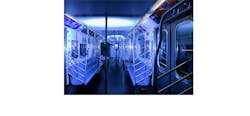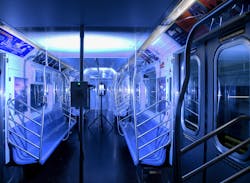As the U.S. grapples with how to interrupt the spread of the highly infectious COVID-19 virus, GUVs are now a key weapon in wiping out viruses, bacteria and other microorganisms from interior spaces. The CDC (Centers for Disease Control & Prevention) and FEMA (Federal Emergency Management Agency) began endorsing the use of GUV in the early 2000s, although its use goes back to the beginning of the nineteenth century.
As electrical wholesalers learn more about this this fairly new product category of disinfectant lighting, they will learn that GUVs require new design and installation techniques and more stringent safety features in many cases.
Distributors should also recognize that right now there’s a bit of a “Wild West” atmosphere with GUVs because some unscrupulous vendors are selling shoddy products (especially directily to consumers) and are making exaggerated claims. This takes away from the lighting developing and selling germicidal lighting products with solid engineering and safety features.
Measured in nanometers (nm), or millionth of a millimeter, ultraviolet (UV) radiation covers wavelengths between 100 nm and 400 nm just beyond the violet portion of the visible light spectrum. The UV spectrum is divided into the UV-A, UV-B and UV-C regions, which are 315 nm to 400 nm, 280 nm to 315 nm and 200 nm to 280 nm, respectively. The UV-C band of ultraviolet radiation from the sun does not reach the earth’s surface, being blocked by the ozone layer in the upper atmosphere, but it is created by different lamp types for germicidal use, and is the only one capable of fighting the COVID-19 pathogens. When a micro-organism is exposed to UV-C, the nuclei of the cells are modified, and as a result, cell division and, by extension, reproduction is prevented.
The three types of UV radiation differ in their biological impact and the extent to which they can fight pathogens. UV-A lamps/fixtures operating at 365 nm can inactivate inactivate MRSA, staph and other bacterial pathogens (lamps operating at 405 nm, in the visible light spectrum can also be used in a similar way).
TYPES OF GUV Lamps
Lamps producing UV-C radiant energy include the low-pressure mercury lamp, operating at 254 nm. It’s identical to a regular fluorescent lamp, except that the lamp’s interior surface lacks a phosphor coating and uses quartz glass. Some types of this lamp also produce radiation at other wavelengths. Still other types of this lamp emit a broad range of UV wavelengths along with visible and infrared radiation.
Called an “excimer lamp,” the far-UV-C lamp, is physically similar to the low-pressure mercury lamp, except that it doesn’t contain mercury. This lamp uses krypton and chloride to produce light at a peak emission of about 222 nm, which appears to be the safest UV wavelength for prolonged human exposure. All of the energy is absorbed by the outer layers of the skin, without penetrating in the way the 254 nm wavelength does. Similarly, the 222nm energy is absorbed almost entirely by the tear layer of the eye.
The pulsed xenon lamp emits a short pulse of broad spectrum (including UV, visible and infrared light), but some xenon lamps are filtered so that only the UV energy for disinfection is emitted. Maintenance and service should be done by authorized personnel.
The UV-C light emitting diode (LED), made from alloys of aluminum nitride, has several advantages over mercury lamps -- no mercury, durability, long life, instant-on operation and a range of wavelengths. While visible light chips can have a useful life of 50,000 hours or more, UV solid-state chips have an expected life of about 9,000 hours. At this stage in its development, the UV LED is relatively expensive and has a very low efficiency compared to visible light LEDs, but improvements in performance are continuous. Market analysts, even prior to COVID 19, predicted a UV LED market exceeding $1 billion in a few years, to be compared with the lighting LED market, which was $4.8 billion in 2019.
Mounting locations. The application of UV-C equipment is challenging, since the air in a space, along with the surfaces and equipment in that space should be treated. Upper-air circulation fixtures mounted high on the upper walls or ceiling of a room to disinfect all of the air in a room are a specific category, and its application has been very successful in the healthcare industry since the 1960s.
Although mounting GUV fixtures in HVAC air ducts is another method, these fixtures do relatively little to prevent person-to-person transmission in a room where both an infected person and other susceptible persons share the same air.
Fixtures for treating the surfaces of a room can be wall- or ceiling-mounted high-bays, louvered or parabolic troffers, under-cabinet and strip units. In general, surface disinfecting fixtures should only be used when the room is vacant (the 222nm source is an exception). Both types of GUV fixtures, but especially those for treating surfaces, are usually considered to be supplementary. That is because the radiation does not reach shadowed recesses of surfaces and does not penetrate dusty surfaces.
Some industry organizations have created brochures, videos and webinars to help in the design and operation of these systems (See sidebar "Where to Go for More Information.). For example, in Sept. 2020, UL issued a document, “UL 8802 Outline of Investigation for Germicidal Systems,” which deals with permanently mounted equipment. Using this document, fixture manufacturers are developing UV-C germicidal lamp systems with control systems that incorporate dedicated occupancy sensors, audible and visual alarms, emergency stop buttons, magnetic door sensors and other measures. Industry experts want governing bodies to formulate detailed and accurate information on the installation and maintenance of these systems, so as not to tarnish this emerging industry.
Shortcomings. While the technology continues to be promising, UVC systems have some shortcomings. For example, all electromagnetic radiation interacts with matter, and in the UV region, this radiation has sufficient energy to cause molecular damage (fading) to building materials, finishes and fabrics. If this factor is considered important, more research aimed at UV resistant paints, plastics and other materials may be needed.
Another issue is that the UVC radiometers used to measure the output of GUV systems are expensive, require frequent recalibration and may not provide an accurate reading. A less expensive way to verify germicidal UV effectiveness is with a single-use card (called a dossier) that is printed with color-changing UVC-sensitive ink.
Lamp life can also be a concern. The GUV low pressure mercury lamps have a much short life than the corresponding visible light lamps: 10,000 to 15,000 hours. Also, the efficiency of these systems goes down as humidity increases.
Generally speaking, manufacturers are now engineering the GUV systems. The luminaries come factory calibrated from the calculations done at the time of specification, using software programs that utilize UV spectral power distribution graphs and UV radiometric distribution graphs.
What the future holds. The virus has been mutating since it was identified a year ago, and there is increasing consensus that globally, SARS-CoV-2 is likely to remain endemic for at least a decade. It is also possible that the virus will be seasonal, with predictable annual peaks. It could also mutate to become even more virulent. Electrical wholesalers interested in GUV technology should study the latest developments and contact manufacturers that provide a range of products, offer instruction and are committed to safety.



